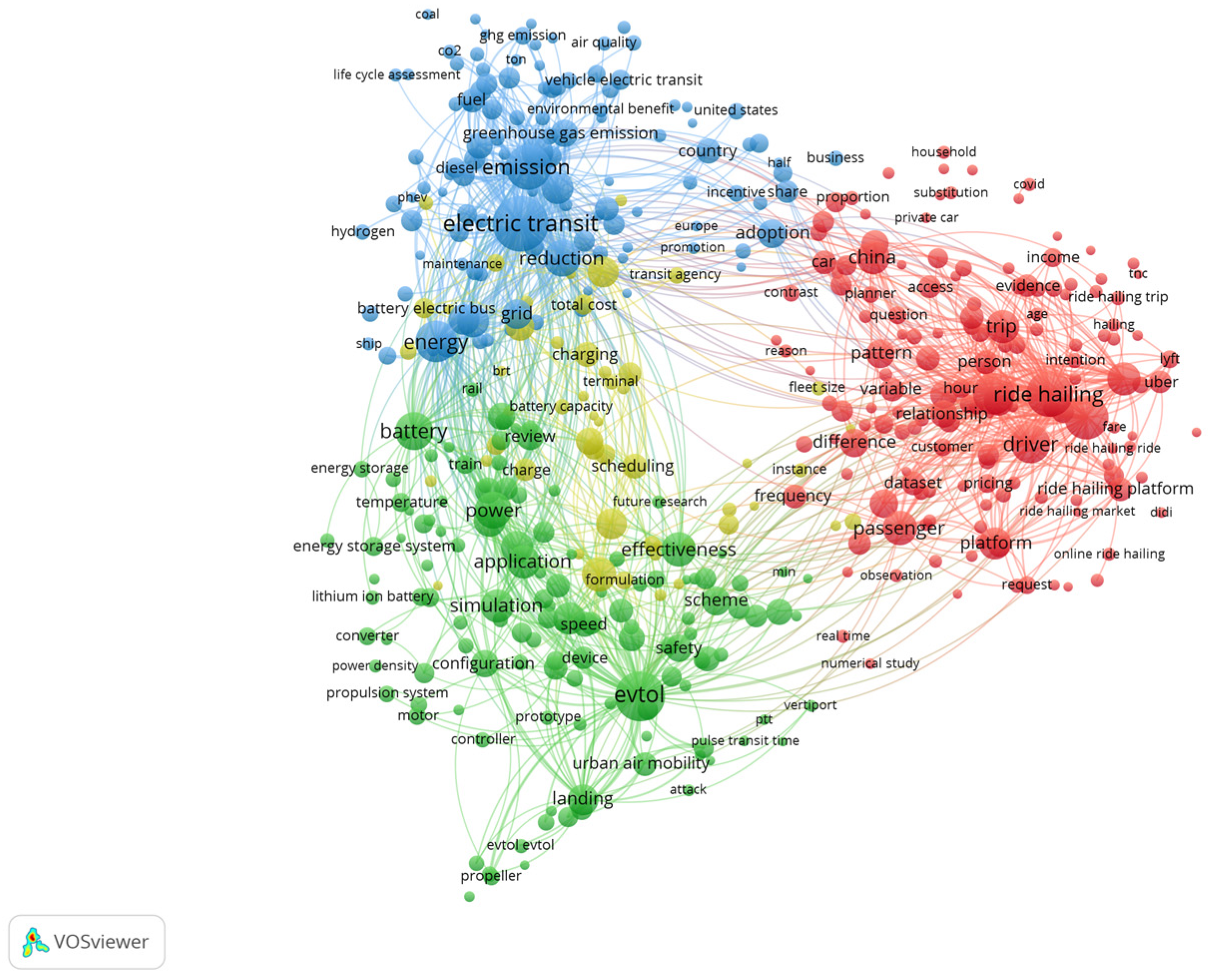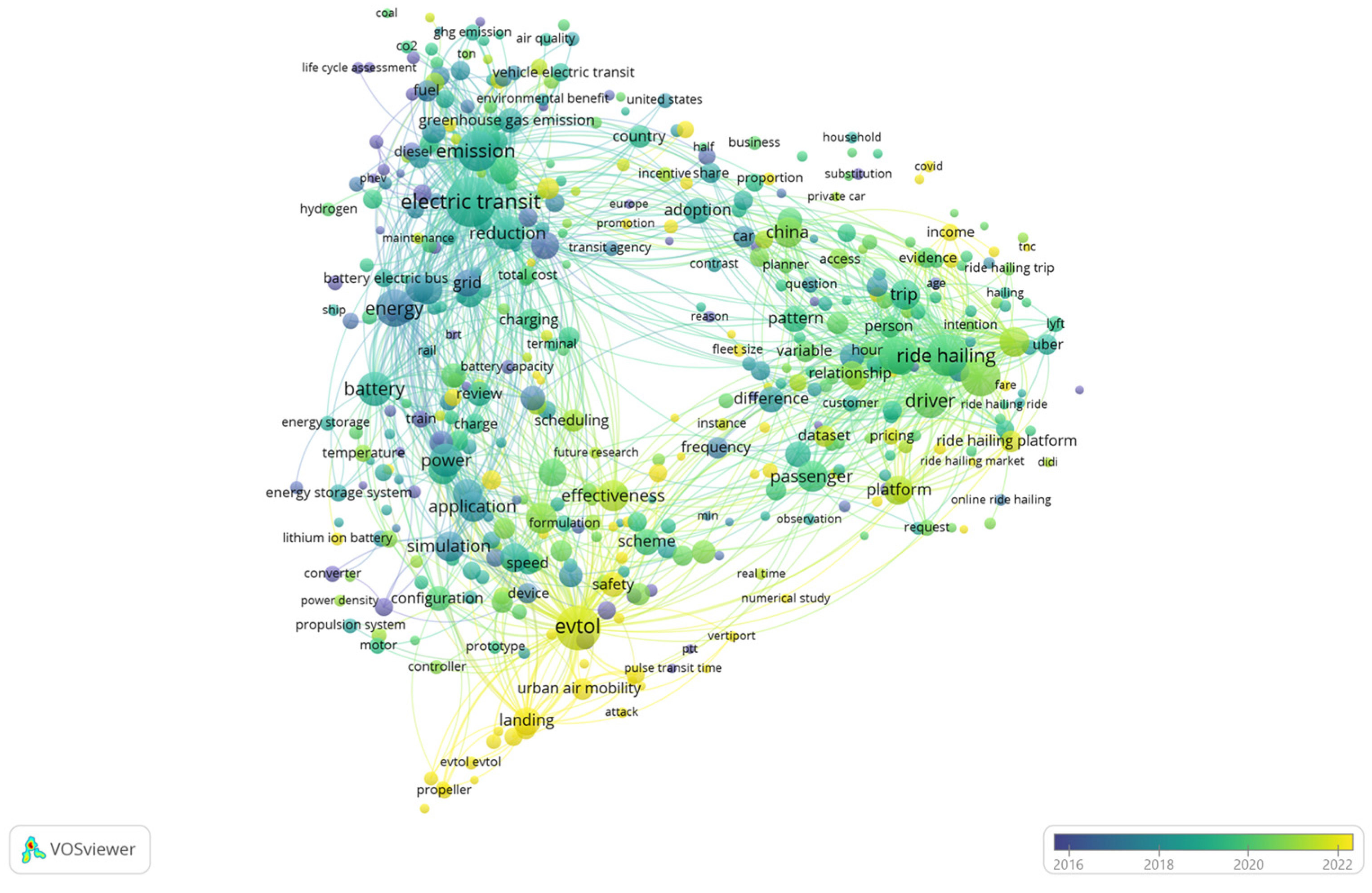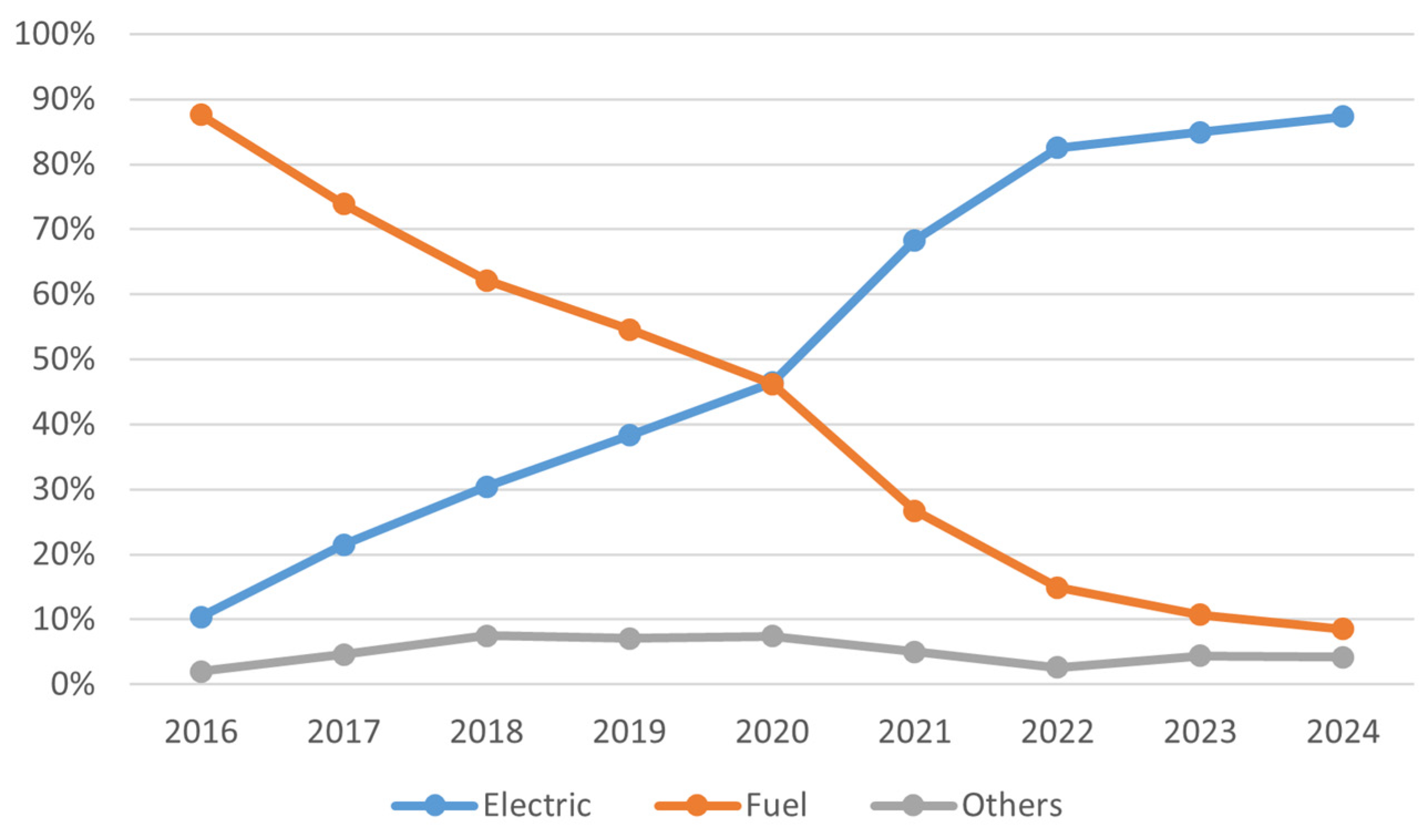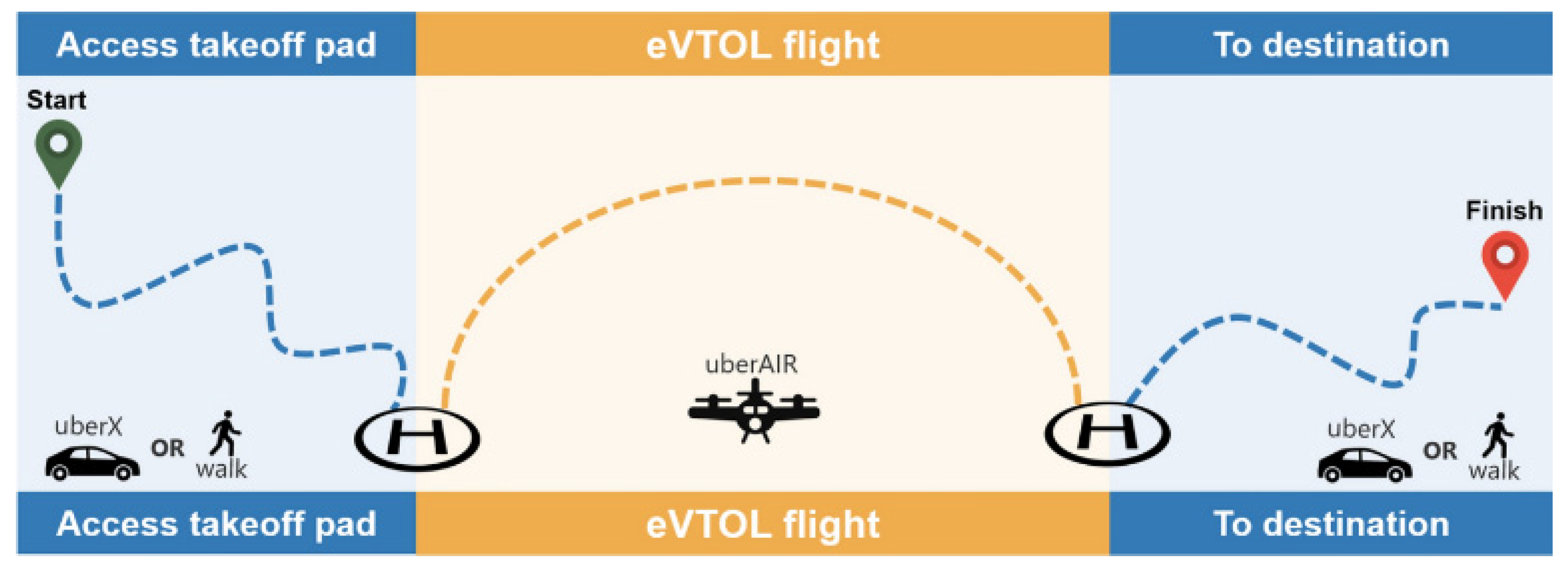Electrification of Integrated Stereoscopic Transportation: A Perspective on the Electric Ride-Hailing, Transit, and Electric Vertical Takeoff and Landing Market in Jiangsu Province
Abstract
1. Introduction
2. Methodology
2.1. Literature Collection
2.2. Literature Processing
3. Analysis
3.1. Keyword Visualization and Analysis Based on VOSviewer
3.2. Electrification Market in Jiangsu Province
3.2.1. Electric Transit
3.2.2. Ride-Hailing
3.2.3. eVTOL Market
3.3. Potential Benefits of Electrification
3.3.1. Environmental Benefits
3.3.2. Social Benefits
3.3.3. Economic Benefits
3.4. Existing Policies and Their Effectiveness
3.4.1. Incentives for EV Adoption
3.4.2. Public Transit Investment
3.4.3. Ride-Hailing Regulations
3.4.4. eVTOL Development
3.5. Challenges and Limitations
3.5.1. Common Challenges
- (1)
- Infrastructure Development
- (2)
- Regulatory Frameworks
3.5.2. Unique Challenges
- (1)
- Public Transit Systems
- (2)
- Ride-hailing Platforms
- (3)
- eVTOL
4. Suggestions
4.1. Develop a Comprehensive Electrification Strategy
4.2. Harmonize Regulations
4.3. Invest in Infrastructure Development
4.4. Promote Public Awareness and Acceptance
5. Conclusions
Author Contributions
Funding
Institutional Review Board Statement
Informed Consent Statement
Data Availability Statement
Conflicts of Interest
References
- Ribeiro, P.J.G.; Dias, G.; Mendes, J.F.G. Public Transport Decarbonization: An Exploratory Approach to Bus Electrification. World Electr. Veh. J. 2024, 15, 81. [Google Scholar] [CrossRef]
- İnce, E.C. Mapping the Path to Sustainable Urban Mobility: A Bibliometric Analysis of Global Trends and Innovations in Transportation Research. Sustainability 2025, 17, 1480. [Google Scholar] [CrossRef]
- Lv, T.; Wang, Y.; Deng, X.; Zhan, H.; Siskova, M. Sustainability transition evaluation of urban transportation using fuzzy logic method-the case of Jiangsu Province. J. Intell. Fuzzy Syst. 2020, 39, 3883–3898. [Google Scholar] [CrossRef]
- Tan, K.M.; Yong, J.Y.; Ramachandaramurthy, V.K.; Mansor, M.; Teh, J.; Guerrero, J.M. Factors influencing global transportation electrification: Comparative analysis of electric and internal combustion engine vehicles. Renew. Sustain. Energy Rev. 2023, 184, 113582. [Google Scholar] [CrossRef]
- China’s First All-Electric Bus Route Launched. 2024. Available online: https://www.itsinternational.com/news/chinas-first-all-electric-bus-route-launched (accessed on 12 January 2025).
- Development Plan for China’s New Energy Vehicle Industry 2021–2025. 2020. Available online: https://www.gov.cn/zhengce/zhengceku/2020-11/02/content_5556716.htm (accessed on 12 January 2025).
- The Provincial Department of Transportation Has Released the “Jiangsu Transportation Technology Development Report 2022”. 2023. Available online: https://jtyst.jiangsu.gov.cn/art/2023/1/11/art_41904_10724511.html (accessed on 12 January 2025).
- The Provincial Department of Transportation Has Released the “Jiangsu Transportation Technology Development Report 2021”. 2022. Available online: https://jtyst.jiangsu.gov.cn/art/2022/1/26/art_41904_10332605.html (accessed on 12 January 2025).
- Implementation Plan for Promoting Large Scale Equipment Renewal in the Transportation Sector in Jiangsu Province. 2024. Available online: https://www.gov.cn/lianbo/difang/202405/content_6961172.htm (accessed on 12 January 2025).
- Du, J.; Li, F.; Li, J.; Wu, X.; Song, Z.; Zou, Y.; Ouyang, M. Evaluating the technological evolution of battery electric buses: China as a case. Energy 2019, 176, 309–319. [Google Scholar] [CrossRef]
- Statistical Bulletin on Transportation Industry Development in 2023-Government Information Disclosure-Ministry of Transportation of China. 2023. Available online: https://xxgk.mot.gov.cn/2020/jigou/zhghs/202406/t20240614_4142419.html (accessed on 12 January 2025).
- Jiangsu to Increase 800 New-Energy Buses-News. December 2024. Available online: https://www.chinabuses.org/news/2013/0625/article_7267.html (accessed on 12 January 2025).
- Policy Report on the Development of Pure Electric Ride Hailing Services. 2024. Available online: https://baijiahao.baidu.com/s?id=1826194842227991666&wfr=spider&for=pc (accessed on 12 January 2025).
- Zhao, Y.; Wen, Y.; Wang, F.; Tu, W.; Zhang, S.; Wu, Y.; Hao, J. Feasibility, economic and carbon reduction benefits of ride-hailing vehicle electrification by coupling travel trajectory and charging infrastructure data. Appl. Energy 2023, 342, 121102. [Google Scholar] [CrossRef]
- Zhu, Y.; Liu, L.; Wang, H. The impact of road passenger transport electrification on reducing carbon dioxide and air pollutants in Jiangsu Province. J. Nanjing Univ. 2022, 58, 989–997. [Google Scholar]
- Wang, Y.; Xie, T.; Yang, S. Carbon emission and its decoupling research of transportation in Jiangsu Province. J. Clean. Prod. 2017, 142, 907–914. [Google Scholar] [CrossRef]
- Wang, Z.; Yang, Y.; Yao, E.; Zhu, Y.; Rao, Z. An analysis of commute mode choice behavior considering the impacts of built environment in Beijing. Transp. Lett. 2022, 14, 733–739. [Google Scholar] [CrossRef]
- China Sharing Economy Development Report (2023). 2024. Available online: http://www.sic.gov.cn/sic/93/552/557/0223/11819_pc.html (accessed on 12 January 2025).
- Ceder, A. Urban mobility and public transport: Future perspectives and review. Int. J. Urban Sci. 2021, 25, 455–479. [Google Scholar] [CrossRef]
- Li, X.; Liu, Y.; Qu, Y.; Ding, L.; Yan, X. Effect of electric vehicles and renewable electricity on future life cycle air emissions from China’s road transport fleet. Energy 2025, 318, 134969. [Google Scholar] [CrossRef]
- Yao, E.; Li, C.; Xun, N.; Yang, Y.; Li, B. Impact of Bike Sharing on Commuter Corridor Trip Structure. J. South China Univ. Technol. (Nat. Sci. Ed.) 2020, 48, 85–92+142. [Google Scholar]
- Ye, J.; Bai, J.; Hao, W. A Systematic Review of the Coopetition Relationship between Bike-Sharing and Public Transit. J. Adv. Transp. 2024, 2024, 6681895. [Google Scholar] [CrossRef]
- Bastarianto, F.F.; Hancock, T.O.; Choudhury, C.F.; Manley, E. Agent-based models in urban transportation: Review, challenges, and opportunities. Eur. Transp. Res. Rev. 2023, 15, 19. [Google Scholar] [CrossRef]
- Wang, H.; Yu, M.; Sun, Z.; Zhang, X.; Ynag, H. Agent-based simulation for shared mobility: A systematic literature review. Highw. Transp. Sci. Technol. 2021, 38, 110–121. [Google Scholar]
- Cai, C.; Ye, M.; Ma, L.; He, J.; Yin, S. Modeling of effective path set generation for urban rail transit based on improved shortest path method. Urban Rail Transit Study 2022, 25, 1–5+10. [Google Scholar] [CrossRef]
- Chen, Q. Modeling Supply and Demand Balance and Pricing Optimization for Internet Rental Car Trips. Ph.D. Thesis, Zhejiang University, Hangzhou, China, 2021. [Google Scholar]
- Chen, J. A Review of Co-Optimization Research on Urban Multi-Modal Transportation Networks and Broad Hubs. Transp. Technol. Econ. 2023, 25, 1–10+31. [Google Scholar] [CrossRef]
- Sun, J.; Qin, G. Digital Twins for Road Transportation Systems: Concepts, Maturity Grading, and Research Perspectives. China Highw. J. 2024, 37, 218–236. [Google Scholar] [CrossRef]
- Luo, Y. Design and Optimization of Public Transportation Systems Considering Bicycle Sharing Connections. Master’s Thesis, Dalian Maritime University, Dalian, China, 2022. [Google Scholar]
- Coney, K.; Cory, K. Battery Electric Bus Deployment Considerations in Developing Countries; NREL/TP-7A40-76816; National Renewable Energy Lab. (NREL): Golden, CO, USA, 2020. [Google Scholar] [CrossRef]
- Yu, J.; Xia, Y.; Huang, Y.; Lv, Z. How we deal with transition planning as we approach the e-bus era. Interdiscip. Humanit. Commun. Stud. 2024, 1, 1–12. [Google Scholar] [CrossRef]
- Xue, L.; Wei, W.; Liu, P.; Liu, D. Analysis of the Current Operation Status and Improvement Countermeasures of Pure Electric Buses in China. J. Resour. Res. Inst. 2019, 1–40. [Google Scholar]
- Ko, Y.K.; Ko, Y.D. A Development of Optimal Design and Operation Algorithm for Battery-Powered Electric City Tour Bus System. Energies 2023, 16, 1100. [Google Scholar] [CrossRef]
- Zhang, Q.; Liu, Y. Promoting electric vehicle adoption in ride-hailing platforms: To control or subsidize? Comput. Ind. Eng. 2024, 191, 110146. [Google Scholar] [CrossRef]
- Tang, X.; Lin, X.; He, F. Robust scheduling strategies of electric buses under stochastic traffic conditions. Transp. Res. Part C Emerg. Technol. 2019, 105, 163–182. [Google Scholar] [CrossRef]
- Bingham, C.; Walsh, C.; Carroll, S. Impact of driving characteristics on electric vehicle energy consumption and range. IET Intell. Transp. Syst. 2012, 6, 29–35. [Google Scholar] [CrossRef]
- Lam, A.Y.S.; Leung, Y.-W.; Chu, X. Autonomous-Vehicle Public Transportation System: Scheduling and Admission Control. IEEE Trans. Intell. Transp. Syst. 2016, 17, 1210–1226. [Google Scholar] [CrossRef]
- Lu, C.-C.; Yan, S.; Huang, Y.-W. Optimal scheduling of a taxi fleet with mixed electric and gasoline vehicles to service advance reservations. Transp. Res. Part C Emerg. Technol. 2018, 93, 479–500. [Google Scholar] [CrossRef]
- Dai, R.; Ding, C.; Gao, J.; Wu, X.; Yu, B. Optimization and evaluation for autonomous taxi ride-sharing schedule and depot location from the perspective of energy consumption. Appl. Energy 2022, 308, 118388. [Google Scholar] [CrossRef]
- Xie, J.; Liu, Y.; Chen, N. Two-Sided Deep Reinforcement Learning for Dynamic Mobility-on-Demand Management with Mixed Autonomy. Transp. Sci. 2023, 57, 1019–1046. [Google Scholar] [CrossRef]
- Li, Y.; Liu, Y. Optimizing flexible one-to-two matching in ride-hailing systems with boundedly rational users. Transp. Res. Part E Logist. Transp. Rev. 2021, 150, 102329. [Google Scholar] [CrossRef]
- Zou, C.; Wang, Y.; Wu, L.; He, J.; Ni, J.; Mao, H. Zhengzhou bus fleet electrification reduces pollution and carbon environmental benefits. Environ. Sci. 2024, 45, 1293–1303. [Google Scholar] [CrossRef]
- Chen, Y.; Zhang, Y.; Coffman, D.; Mi, Z. An environmental benefit analysis of bike sharing in New York City. Cities 2022, 121, 103475. [Google Scholar] [CrossRef]
- Yang, S. Research on Carbon Emission Right Trading Mechanism for Personal Transportation Based on Subject Modeling. Master’s Thesis, Harbin Institute of Technology, Harbin, China, 2022. [Google Scholar]
- Chen, R.; Xu, S.; Du, Y.; Wu, Y.; Zhao, S.; Tu, R.; Wu, C. Carbon Generalized System of Preferences (CGSP) programs: Key design dimensions and attitudes of potential participants. Case Stud. Transp. Policy 2024, 16, 101205. [Google Scholar] [CrossRef]
- Ma, J.; Xu, M.; Jiang, J. Mapping high-resolution urban road carbon and pollutant emissions using travel demand data. Energy 2023, 263, 126059. [Google Scholar] [CrossRef]
- Song, F.; Hess, S.; Dekker, T. Uncovering the link between intra-individual heterogeneity and variety seeking: The case of new shared mobility. Transportation 2024, 51, 371–406. [Google Scholar] [CrossRef]





Disclaimer/Publisher’s Note: The statements, opinions and data contained in all publications are solely those of the individual author(s) and contributor(s) and not of MDPI and/or the editor(s). MDPI and/or the editor(s) disclaim responsibility for any injury to people or property resulting from any ideas, methods, instructions or products referred to in the content. |
© 2025 by the authors. Published by MDPI on behalf of the World Electric Vehicle Association. Licensee MDPI, Basel, Switzerland. This article is an open access article distributed under the terms and conditions of the Creative Commons Attribution (CC BY) license (https://creativecommons.org/licenses/by/4.0/).
Share and Cite
Ma, J.; Diao, W.; Li, J.; Zhang, L. Electrification of Integrated Stereoscopic Transportation: A Perspective on the Electric Ride-Hailing, Transit, and Electric Vertical Takeoff and Landing Market in Jiangsu Province. World Electr. Veh. J. 2025, 16, 165. https://doi.org/10.3390/wevj16030165
Ma J, Diao W, Li J, Zhang L. Electrification of Integrated Stereoscopic Transportation: A Perspective on the Electric Ride-Hailing, Transit, and Electric Vertical Takeoff and Landing Market in Jiangsu Province. World Electric Vehicle Journal. 2025; 16(3):165. https://doi.org/10.3390/wevj16030165
Chicago/Turabian StyleMa, Jie, Weile Diao, Jingzhi Li, and Linfeng Zhang. 2025. "Electrification of Integrated Stereoscopic Transportation: A Perspective on the Electric Ride-Hailing, Transit, and Electric Vertical Takeoff and Landing Market in Jiangsu Province" World Electric Vehicle Journal 16, no. 3: 165. https://doi.org/10.3390/wevj16030165
APA StyleMa, J., Diao, W., Li, J., & Zhang, L. (2025). Electrification of Integrated Stereoscopic Transportation: A Perspective on the Electric Ride-Hailing, Transit, and Electric Vertical Takeoff and Landing Market in Jiangsu Province. World Electric Vehicle Journal, 16(3), 165. https://doi.org/10.3390/wevj16030165







